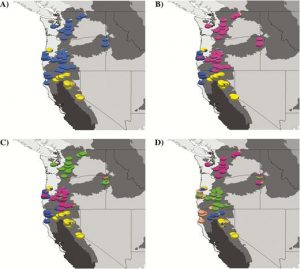The Sierra Nevada range towers over the Basin below, cutting the skyline with a jagged edge as far as the eye can see. Mountain ranges, like the Sierra Nevada, are symbolic of western North America and present barriers not only to most day hikers, but to many plants and animal too. For many alpine taxa, mountain ranges may act like a chain of islands, where movement among isolated peaks (islands) is possible but movement among ranges (archipelagos) rarely, if ever, happens. By restricting movement, topological features can play an important role in the diversification of western North American taxa.
Genetic data can shed light on cryptic variation among populations within species, illuminating genetic signatures of historic biogeographic barriers which carved two lineages where there once was one. This understanding is critical to the conservation of biodiversity under the U.S. Endangered Species Act and the Canadian Species At Risk Act, which target conservation units – unique and significant evolutionary lineages represented by species, subspecies, and subpopulations.
Recent research published in the Journal of Heredity and currently freely available set out to identify the conservation units of marten in the western United States. While the marten’s distribution in Canada is more or less continuous, martens distribution is fragmented in the western U.S., as most populations are restricted to mountain ranges which support mature forests. Land clearing and logging of mature coniferous and mixed forests threatens marten populations, underlining the importance of delineating conservation units to inform future conservation efforts.
Harnessing whole mitochondrial genomes and 13 microsatellite loci, Schwartz et al. (2020) confirmed that North American martens comprise two distinct species, Pacific (Martes caurina) and American marten (M. Americana). Within the Pacific martens, Schwarz et al. (2020) detected two distinct mitochondrial lineages, one associated with the southern Cascade/Sierra mountain ranges and the other with northern Cascade/Coastal ranges. Based on divergence time estimation in this group, the Cascade/Sierra lineage diverged from the Cascade/Coastal lineage approximately 2.23 mya, coincident with the uplift of the Cascade mountain chain. This phylogenetic break was likewise recovered in other species inhabiting mesic, Pacific Northwest forests, suggesting that evolution in these species has responded similar to shared environmental and/or historic processes.

Genetic data uncovered substantial genetic substructure within the Pacific marten, identifying five subgroups which were consistent with historical designations and corresponding to five distinct ecoregions throughout the west. Some distant populations, from the Sierra Nevada and the Olympic Peninsula, appear to have diverged recently, suggesting a complex history of recolonization since the last glacial maximum.
As the climate warms, forested alpine habitat preferred by martens may shift or fragment, putting these populations at risk of extirpation. Studies like these, which clarify taxonomic boundaries and delineate conservation units, are essential to making the effective conservation decisions given limited time and resources in a rapidly changing world.

Katie Uckele is a Ph.D candidate working in Dr. Thomas Parchman’s lab at the University of Nevada Reno. She investigates the genetic and ecological consequences of hybridization among long-lived conifers in western Nevada.



